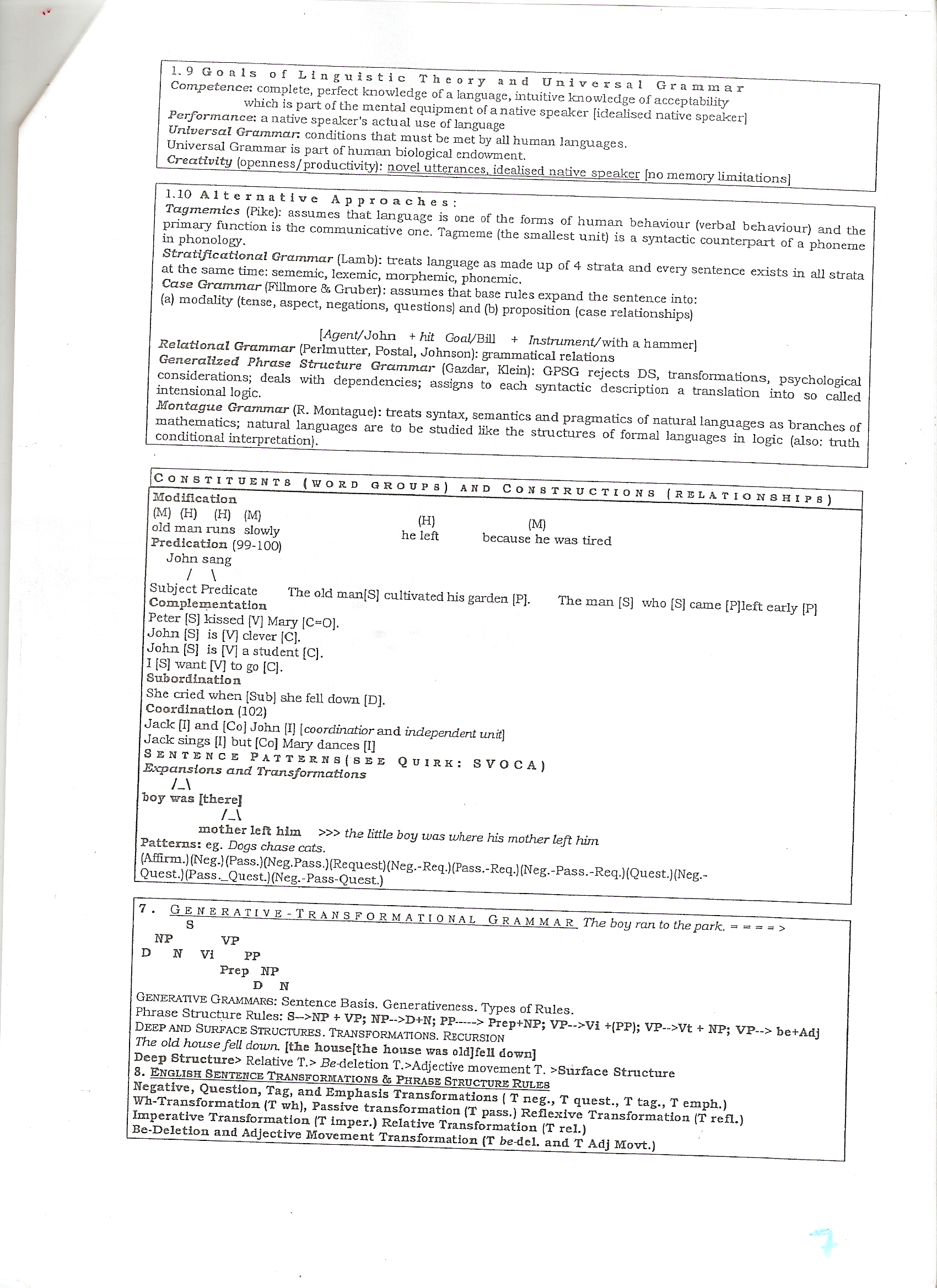lingwistyka 7

1.9 Goals of Linguistic Theory and Unirersal Grammar Competence: complete, perfect knowledge of a Ianguage, intuitive łcnowledge of acceptability
which is part of the mcntal eąuipment of anative speaker (idealised native speaker] Performance: a native speaker's actual use of Ianguage Uniuersal Grammar: conditions that must be met by all human Ianguage s.
Universal Grammar is part of human biological endowment.
Creatiyity (opemiess/productivity): noveI utterances. idealised natiye speaker [no memory ŁLmitations]
1.10 Alternative Approaches:
Tagmemics (Pikę): assumes that Ianguage is one of the forms of human behaviour (verbal behaviour) and the primary function i3 the communicative one. Tagmeme (the smallest unit) is a syntactic counterpart of a phoneme in phonology.
Stratificational Grammar (Lamb): treats Ianguage as madę up of 4 strata and every sentence exists in all strata at the same tiine: sememic, lexemic, morphemic, phonemic.
Case Grammar (FiUmore & Gruber): assumes that base rules expand the sentence into:
(a) modality (tense, aspect, negations, ąuestions) and (b) proposition (case relationships)
[Agent/John + hit Goal/Bill + Instrument/with a hammer)
Relational Grammar (Perłmutter, Postał, Johnson): grammatical relations
Generalized Phrase Structure Grammar (Gazdar, Klein): GPSG rejects DS, transfomiations, psychological considerations; deals with dependencies; assigns to each syntactic description a translation into so called intensional logie.
Montague Grammar (R. Montague): treats syn.tax, semantics and pragmatics of natural languages as branches of mathematics; natural languages are to be studied like the structures of formal languages in logie (also: truth conditLonal interpretation). _
COMBTITPENTS (WORD GROUP3) AMD COMBTROCTION8 (RELATIONSHIPS) I Modification
(M) (H) (H) (M) (H) (M)
old man runs slowly he left because he was tired
Predlcation (99-100)
John sang
/ \
Subject Predicate The old man[S] cultivated bis garden (PJ. The man [S] who [S] came [P]left early [P]
Complementatłon
Peter [SJ łdssed [V] Mary [C=0].
John [S] is [V] dever [C],
John [S] is (V| a student [C].
I (S] want [V] to go [CJ.
Sub or dinatio n
She cried when [Sub] ahe fell down [D].
Coordinatlon (102)
Jack [I] and (Co) John [I] [coordinatior and independent unit]
Jack sings [I] but [Co] Mary dances [1]
Sentence Patterhs(see Quirk: S70CA)
Expanslons and Transformations
JA
'boy was [there]
/_V
mother left falm »> the little boy was wkere his mother left him Pattems: eg. Dogs chase cats.
(A£Bxm.)(Neg.)(Pass.)(Neg.Pass.)(Request)(Neg.-Req.)(Pass.-Req.)(Neg.-Pass.-Req.)(Quest.)(Neg.-Quest.)(Pass._Quest.)(Neg.-Pass-Quest.)___
7 . Genbrative-Tran3FORMatiqnal Grammar The boy ran to the park. =*■==*=*>
S
NP VP
D N Vi PP
Prep NP D N
Generative Grammarb: Sentence Basis. Generativeness. Types of Rules.
Phrase Structure Rule3: S->NP *- VP; NP~>D+N; PP---> Prep+NP; VP->Vi +(PP); VP~>Vt + NP; VP-> be+Adj
Deep and Surface Structures. Transformations. Rłcursion The old housefell down. [the housejthe house was old]fell down]
Deep Stracture> Relative T.> Be-deletion T.>Adjective movement T. >Surface Structure 8. Englibh Sentence Transformations & Phrase Structure Rules
Negative, Question, Tag, and Emphasis Transformations ( T neg., T quest., T tag., T emph.) Wh-Transformation (T wh), Passive transformation (T pass.) Reflexive Transformation (T refl.)
Imperatlve Transformation (T imper.) Relative Transformation (T rei.)
Be-Deletion and Adjective Movement Transformation (T be-del. and T Adj Movt.)_
Wyszukiwarka
Podobne podstrony:
A New Look at Family-orientated Social Work from the Viewpoint of Systems Theory and Constructivism
MANAGEMENT I THEORY 1 AND PRACTICE NO. 1(7) YEAR 2013 TABLE OF CONTENTS 11 Editorial ARTICLES A
Public Risk ManagementTome IPerspective of Theory and Practice Ediced by Piotr TWOREK Józef
111. SchaunYs Outline of Theory and Problems of Strenght of Materials / William
Comparison of theory and test result 9 " Israeli Syn Jet Engines Turbi Jet temperaturę alo
ji i Sino-Polish Perspectives on the Theory and Practice of Contract Law Edited by Piotr Grzeby
407 ABOUT THE CONTRIBUTORS theory of classification, theory of scientific information, theory and pr
1. Teoria i zasady projektowania miejsc pracy Theory and Principles of designing
Jan Buzalka Summary Fulfillment of an integrated scientific research task "Theory and methodolo
32 Konrad Dramowicz (36) Massey D. Problems of location: gamę theory and gaming
Lost Highway! 188 Studying Contemporary American Film he develops a systematic theory and methodolog
Metodyka 4 HMa ioboux 4(yM A IN GOALS OF G-T METHOD *ability to read and appreciat
BIBLIA NLP Bandler Richard. Grinder John. Reframing: Neuro-Linguistic Programming and The Tronsforma
PRZEGLĄDEUROPEJSKI Political and economic aspects of security i n the EU -theory and.practice 2020 B
więcej podobnych podstron